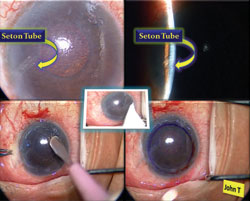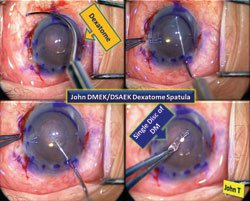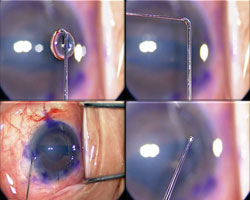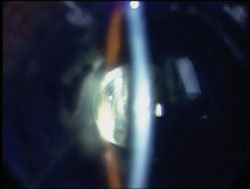Descemet’s membrane endothelial keratoplasty a useful technique for selective tissue corneal transplantation
The technique allows for faster visual recovery and better final visual acuity compared to DSAEK.
 Thomas John |
Corneal transplantation has rapidly evolved from full-thickness penetrating keratoplasty to selective tissue corneal transplantation, ending surgically induced astigmatism and improving quality of vision. Selective tissue corneal transplantation includes anterior and posterior lamellar keratoplasty, where only the diseased portions of the patient’s corneal tissue are replaced with similar healthy donor corneal tissue.
For endothelial decompensation, the preferred surgical approach for most corneal surgeons is Descemet’s stripping automated endothelial keratoplasty. DSAEK is a “tissue-addition” procedure, with increased thickness of the recipient cornea and surgically induced hyperopia. A more advanced selective tissue corneal transplantation technique is Descemet’s membrane endothelial keratoplasty, or DMEK. DMEK is a “tissue-substitution” procedure, with normal corneal thickness maintained, no induced hyperopia, faster visual recovery and better final visual acuity compared with DSAEK.
In this column, I describe the DMEK technique in an eye with an AcrySof ReSTOR (Alcon) posterior chamber IOL in the presence of an Ahmed valve (New World Medical) tube in the anterior chamber. In this case, the view to the anterior chamber was compromised due to a very cloudy cornea caused by extensive pseudophakic bullous keratopathy.
Preparing the recipient cornea
Either monitored anesthesia care or general anesthesia may be used. My preference in DMEK procedures is monitored anesthesia care. In addition to monitored anesthesia care, 2% lidocaine jelly is applied to the ocular surface. The seton tube within the anterior chamber is barely visible as seen with the broad beam and intra-operative slit lamp views (Figure 1, arrows). Because of very poor visualization of the anterior segment, the corneal epithelium is removed using Weck-Cel spears (Medtronic Ophthalmics) and a straight crescent blade (Figure 1). The anterior chamber is entered close to the limbus using a 15° superblade, and sodium hyaluronate (Healon, Abbott Medical Optics) is injected into the anterior chamber to fill it. A John Dexatome spatula (ASICO) is used to perform the descemetorhexis and detach and remove the Descemet’s membrane as a single disc (Figure 2). An inferior peripheral iridectomy is performed using micro-scissors. Through a temporal 3-mm corneal wound, Healon is evacuated using an irrigation and aspiration unit, and the pupil is constricted using acetylcholine chloride (Miochol, Novartis Ophthalmics). The temporal wound is then closed with a single 10-0 nylon suture. The new John DMEK instrument set (ASICO) (Figures 3 and 4) helps facilitate the DMEK procedure.
 Figure 1. Top row: Severe pseudophakic bullous keratopathy and Ahmed valve tube in the anterior chamber are seen in the broad and slit-view images. Bottom row and insert: Epithelial removal to enhance view of the anterior chamber. |
 Figure 2. John DMEK/DSAEK Dexatome spatula (ASICO), used for descemetorhexis and removal of the Descemet’s membrane as a single disc, allows easy contact with any region of the inner corneal surface of the patient’s cornea. |
 Figure 3. Top row and bottom left: John DMEK cannula (ASICO) for fluid-assisted unraveling of the donor Descemet’s membrane within the recipient anterior chamber, taking care to limit contact between the Descemet’s membrane and the seton tube to prevent endothelial cell loss. |
 Figure 4. Top left: Trypan blue-stained donor Descemet’s membrane in John DMEK block (ASICO); Top right, bottom row and insert: John DMEK cannula is used for fluid-assisted unraveling of the donor Descemet’s membrane within the recipient anterior chamber. Contact between the donor Descemet’s membrane and the seton tube in the anterior chamber is limited to prevent endothelial cell loss. |
 Figure 5. Intraoperative slit lamp view of the ReSTOR posterior chamber IOL (Alcon) through a partially clear recipient cornea following donor Descemet’s membrane attachment to the recipient cornea. |
 Figure 6. Top and bottom rows: Attachment of the donor Descemet’s membrane to the patient’s cornea using a big-bubble technique in the presence of an inferior peripheral iridectomy; Inserts: Intraoperative slit lamp views showing the attached donor Descemet’s membrane to the recipient cornea and clearing of the patient’s cornea. Images: John T |
Transplanting the donor cornea
Donor corneal tissue is placed in the two-well John DMEK block (ASICO), and the Descemet’s membrane is detached and then trephined to the desired diameter. It is then placed in the second well and stained with trypan blue (VisionBlue, Dutch Ophthalmic) (Figure 4).
The 10-0 nylon suture is removed, and the Descemet’s membrane is introduced into the anterior chamber via the temporal wound. The Descemet’s membrane is unfolded away from the seton tube using air and sterile balanced salt solution with a John DMEK cannula and John DMEK crystal spatula (both ASICO) (Figures 3 and 4). Figure 5 shows the intraoperative slit lamp view of the ReSTOR posterior chamber IOL through the partially clear recipient cornea following the attachment of the donor Descemet’s membrane and healthy endothelial cells. Descemet’s membrane is attached to the recipient cornea with a big bubble, free of any contact with the seton tube in the anterior chamber (Figure 6).
Key points
- Unfold Descemet’s membrane away from the seton tube in the anterior chamber.
- Avoid or limit any direct contact between Descemet’s membrane and the Ahmed valve tube.
- Ensure peripheral iridectomy is full-thickness.
- Avoid any damage to the conjunctiva and Ahmed valve located in the supero-temporal quadrant.
Advantages of DMEK
- Cost-saving procedure compared to DSAEK.
- No need for any type of glide.
- No artificial anterior chamber is required.
- No precut tissue from the eye bank is needed.
- No expensive microkeratome is required.
References:
- Fernandez MM, Afshari NA. Endothelial keratoplasty: from DLEK to DMEK. Middle East Afr J Ophthalmol. 2010 ;17(1):5-8.
- Lie JT, Groeneveld-van Beek EA, Ham L, van der Wees J, Melles GR. More efficient use of donor corneal tissue with Descemet membrane endothelial keratoplasty (DMEK): two lamellar keratoplasty procedures with one donor cornea. Br J Ophthalmol. 2010; doi:10.1136/bjo.2009.171629.
- Melles GR, Ong TS, Ververs B, van der Wees J. Descemet membrane endothelial keratoplasty (DMEK). Cornea. 2006;25(8):987-90.
- Thomas John, MD, OSN Cornea/External Disease Board Member, is a clinical associate professor at Loyola University Chicago and is in private practice in Tinley Park and Oak Lawn, Ill. He can be reached at 708-429-2223; fax: 708-429-2226; e-mail: tjcornea@gmail.com. Dr. John receives a small royalty from ASICO.

